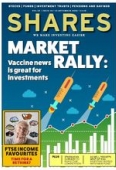Archived article
Please note that tax, investment, pension and ISA rules can change and the information and any views contained in this article may now be inaccurate.
Investor diary: Expanding horizons

We’re pleased to welcome back Malcolm from Edinburgh who is sharing his experience as someone in retirement taking charge of their investments for the first time. Having explained out how he set up his first portfolio Malcolm turns to how he is managing his investments.
In an earlier column I explained my attempts at managing new investments in a SIPP and ISA pension fund.
I detailed how half of the £190,000 trust was in cash and funds and half in shares, which were either ‘succeeding’, generally making ‘sound’ progress but hampered by the impact of Covid-19 or ‘sinking’ and falling markedly in value.
Against this mixed backdrop, I was interested in further expanding my horizons and reviewing whether investing in the AIM market and global markets were a better prospect.
At the same time, my plan has focused on damage limitation, as the first six months trading resulted in a 9% loss of £13,500; a not unexpected outcome given that trading began before the onset of Covid-19. These figures have remained broadly similar since then as have my share categories.
Taylor Wimpey (TW.) and Vodafone (VOD) continued their decline from ‘sound’ to ‘sink’ shares but little other movement has taken place. So close to half my 25 shares are in profit or less than 5% in deficit, just above a quarter of shares are between 5-20% in loss and the remaining ‘sink’ shares are anything up to 55% below purchase price.
AVOIDING LOSSES CONCENTRATES THE MIND
Therefore, avoiding further losses concentrates the mind and compounding my situation is reluctance so far to sell loss-making shares. This has led to a degree of stasis as while many of my ‘sound’ shares have partially recovered they have yet to become surplus making ‘succeeding’ shares.
As such, freeing up money for new investments has been problematic. I am anticipating that as my investment in two funds edge closer to recovery and profit, I will decrease my investment in them. I have not found the added tier of decision making control that exists with funds to be appealing and neither has the funds route been particularly successful.
To fill the current funding gap, I have ignored the often offered sage advice to hold shares for the medium and longer term as this does not necessarily fit with current times. ‘Succeeding’ shares such as Melrose Industries (MRO), Persimmon (PSN), Redrow (RDW), SSE (SSE) and UDG Healthcare (UDG) have proved straightforward to sell for profit and reinvest in later when their share price has fallen.
SELLLING TOO EARLY NOT A PROBLEM TO DATE
Selling too early and missing out on later profits has not proved a problem so far. Thus, while I would like to buy shares based on their stability and earnings growth, responding to share price volatility has yielded straightforward gains so far.
A variation on this approach has been considering whether to buy more of my ‘sink’ shares (BP (BP.), Coca-Cola, Royal Dutch Shell (RDSB), Taylor Wimpey, Vodafone & Wood Group (WG.)). Buying more of these shares at lower prices would lessen the extent to which the shares were down overall and increase the chance of being sellable at some point in the future.
I briefly sketched out the logic of this idea across the dinner table. Little was said but the looks were telling and this strategy is unlikely to be happening anytime soon despite its possible merits. That said I
did sell for a profit SIPP shares held in Hikma Pharmaceuticals (HIK) while retaining some shares in the company as part
of my ISA investments.
LOOKING TO AIM
In the meantime, time has been spent identifying possible new shares from the AIM market to purchase. Following a plan consisting of reading and listening to news updates coupled with analysing share price charts and the price-to-earnings ratio, around a dozen shares were identified. Unease about investing in the AIM market was lessened by scrutinizing the market capitalisation figures for these companies over the last year relative to those in the FTSE 100.
Three shares have been bought, each in areas I have most investments in: construction (James Halstead (JHD:AIM)); minerals (Central Asia Metals (CAML:AIM)) and pharmaceuticals (Alliance Pharma (APH:AIM)). Mixed success is evident to date; a situation which matches my modest buying on the global Xetra market for shares in Bayer and BASF – pharmaceuticals again.
Recently, a lot of financial news attention has been given to dividend yields. Relative to the small amounts I have invested (typically £4,000 to £8,000 per share) this is a modest matter to consider. I am increasingly impressed though by companies that offer clear reasoning about why their dividend payments are being reduced or cancelled.
HOMEWORK TO CONTINUE
In the months ahead, the homework process will continue as I sift my way through the vast amount of evidence available to scrutinize. Research is often in life hindered by lack of information but in the financial world sifting out extraneous information which may not impact on decision making is needed.
DISCLAIMER: ‑The views in this article are those of the author and not of Shares or AJ Bell, the owner of Shares. Readers should consult a suitably qualified financial adviser if they are unsure about managing their own investments. Past performance is not a guide to future performance and some investments need to be held for the long term.
To read the first part in this series click here
Important information:
These articles are provided by Shares magazine which is published by AJ Bell Media, a part of AJ Bell. Shares is not written by AJ Bell.
Shares is provided for your general information and use and is not a personal recommendation to invest. It is not intended to be relied upon by you in making or not making any investment decisions. The investments referred to in these articles will not be suitable for all investors. If in doubt please seek appropriate independent financial advice.
Investors acting on the information in these articles do so at their own risk and AJ Bell Media and its staff do not accept liability for losses suffered by investors as a result of their investment decisions.

 magazine
magazine








